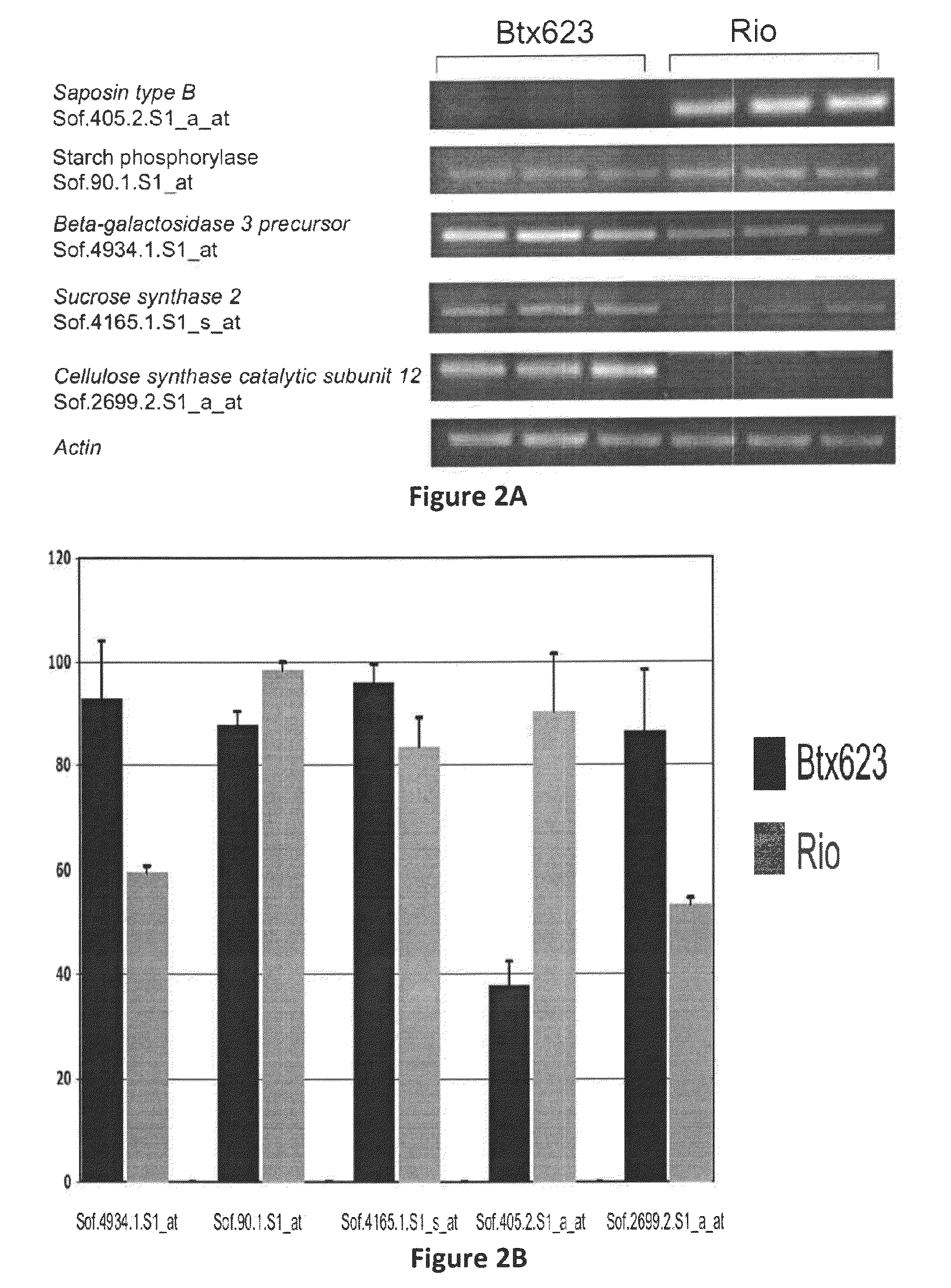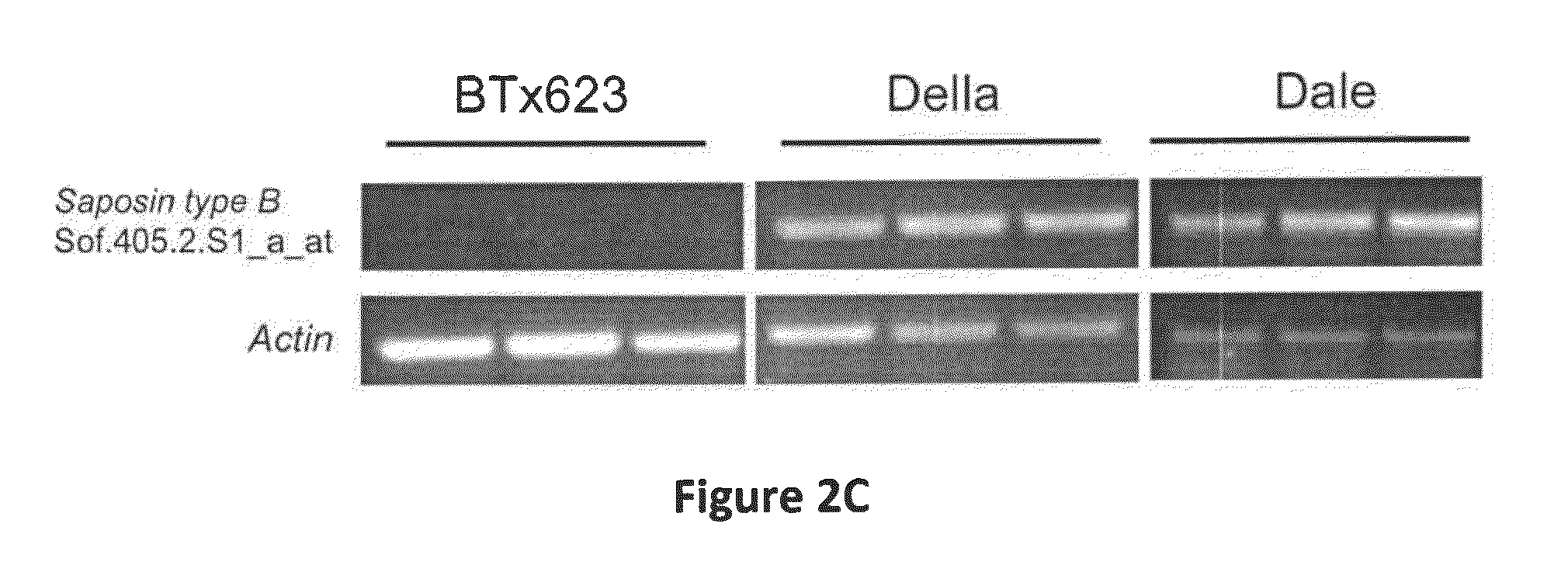Compositions and Methods for Biofuel Crops
a biofuel crop and biofuel technology, applied in biochemistry apparatus and processes, organic chemistry, sugar derivatives, etc., can solve the problems of corn stover remaining untapped for bioethanol conversion, low yield of maize, and inability to grow sugarcane, so as to reduce lignocellulose production, increase sugar production, and increase sugar production
- Summary
- Abstract
- Description
- Claims
- Application Information
AI Technical Summary
Benefits of technology
Problems solved by technology
Method used
Image
Examples
example 1
Gene Identification
[0103]Plant Materials and Growth Conditions
[0104]Seeds from both grain and sweet sorghum (Sorghum bicolor (L.) Moench) were sown in pro-mix soil (Premiere Horticulture Inc., USA) and grown in our greenhouse with a day length of 15 hrs light: 9 hrs dark at constant temperature of 23° C. The genotype representing grain sorghum in our study was BTx623 whereas the genotypes representing sweet sorghum were Dale, Della, M81-E, Rio, Simon and Top76-6. The seeds from sweet sorghum were kindly provided by Dr. William L. Rooney of Texas A&M, College Station, Tex.
[0105]Measurement of “Brix Degree” from Sorghum Stem's Juice
[0106]The juice from internodes of the main stem in both grain and sweet sorghum was harvested at the time of anthesis. A section of approximately 6 cm long was dissected from the middle of each internode and 300 μl of juice was extracted by pressing each internode with a garlic squeezer. The concentration of total soluble sugars in the juice was measured w...
example 2
Comparison of Flowering Time to Brix Degree
[0118]Sweet sorghum and sugarcane are closely related grass species that accumulate sugars in their stems. These sugars can be fermented to ethanol. Sugar accumulation in both species is maximized at the time of flowering. Sorghum is considered as a short day plant, which means that it flowers earlier under short days (defined as 10 hours of light and 14 hours of dark), than under long days (defined as 16 hours of light and 8 hours of dark). With the introduction of sweet sorghum as a biofuel crop, the development of cultivars fully adapted to different geographic regions varying in day length and climate is needed.
[0119]Our preliminary data suggests a link between flowering time and sugar accumulation in sorghum. When sugar accumulation is measured in F2 plants derived from the cross of grain sorghum (low sugar and early flowering) with sweet sorghum (high sugar and late flowering), the stems of late flowering F2 plants displayed higher su...
example 3
Molecular Markers for Sweet Sorghum Based on Microarray Expression Data, SFP Discovery in Sorghum
[0123]In Example 3, using an Affymetrix sugarcane genechip we previously identified 154 genes differentially expressed between grain and sweet sorghum set forth above in Example 1. Although many of these genes have functions related to sugar and cell wall metabolism, dissection of the trait requires genetic analysis. Therefore, it would be advantageous to use microarray data for generation of genetic markers, shown in other species as single feature polymorphisms (SFPs). As a test case, we used the GeSNP software to screen for SFPs between grain and sweet sorghum. Based on this screen, out of 58 candidate genes 30 had SNPs, from which 19 had validated SFPs. The degree of nucleotide polymorphism found between grain and sweet sorghum was in the order of one SNP per 248 base pairs, with chromosome 8 being highly polymorphic. Indeed, molecular markers could be developed for a third of the c...
PUM
| Property | Measurement | Unit |
|---|---|---|
| temperature | aaaaa | aaaaa |
| flowering time | aaaaa | aaaaa |
| composition | aaaaa | aaaaa |
Abstract
Description
Claims
Application Information
 Login to View More
Login to View More - R&D
- Intellectual Property
- Life Sciences
- Materials
- Tech Scout
- Unparalleled Data Quality
- Higher Quality Content
- 60% Fewer Hallucinations
Browse by: Latest US Patents, China's latest patents, Technical Efficacy Thesaurus, Application Domain, Technology Topic, Popular Technical Reports.
© 2025 PatSnap. All rights reserved.Legal|Privacy policy|Modern Slavery Act Transparency Statement|Sitemap|About US| Contact US: help@patsnap.com



